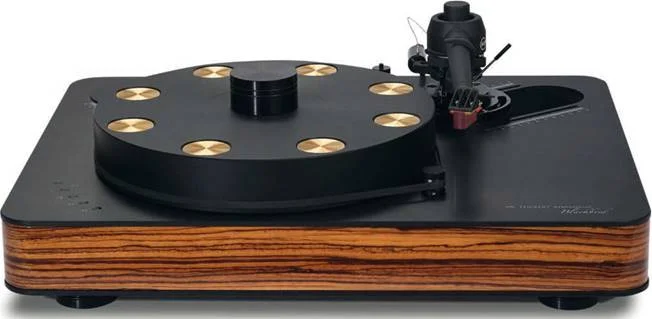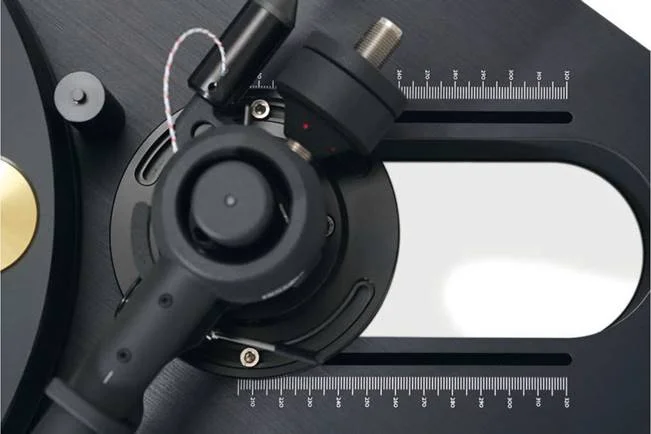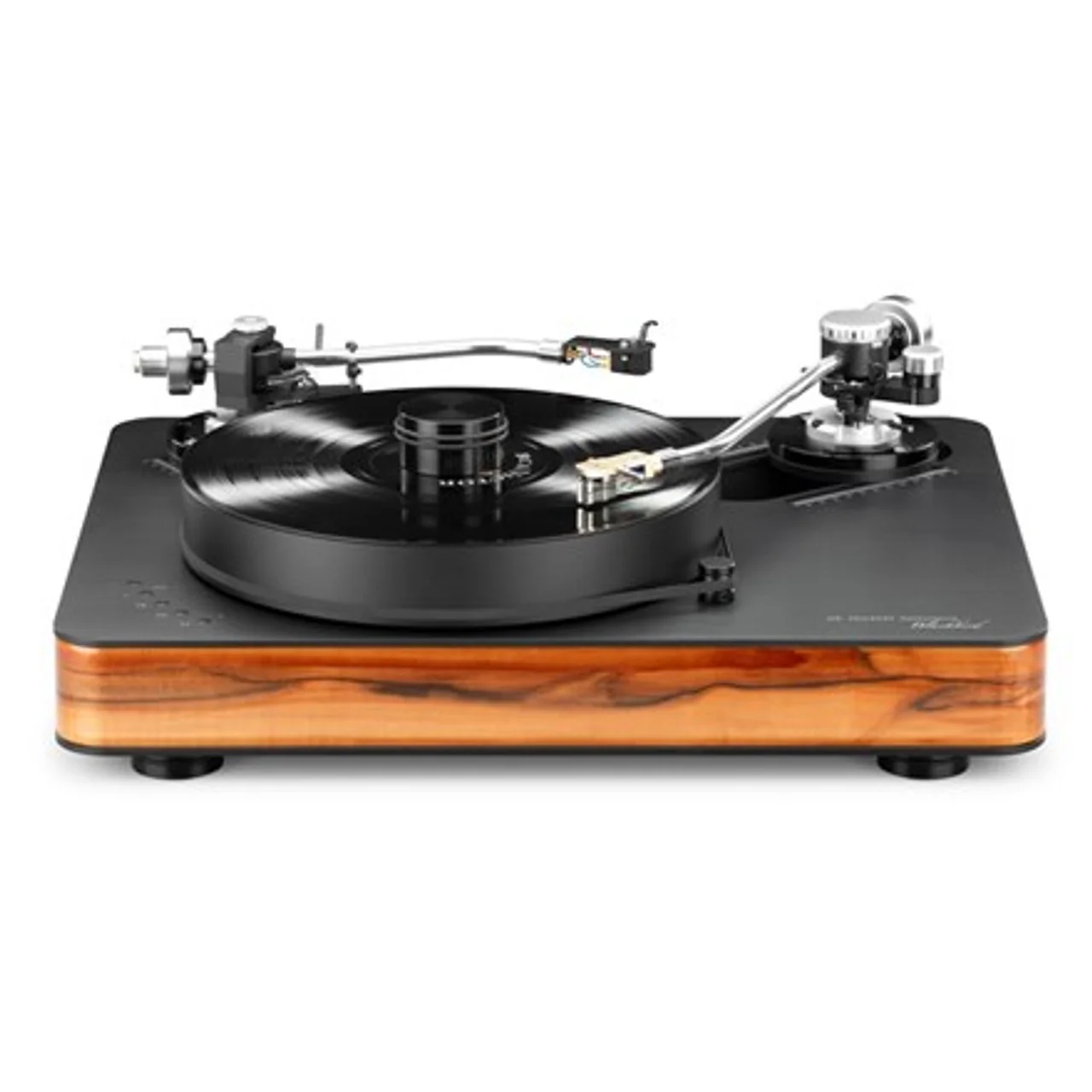315.000.000 ₫
Bảo hành 12 Tháng
Còn hàng
Phiên bản đi kèm cần Reed 3P Wenge 1.25m RCA WBT 12″ giá: 315.000.000 đồng.
Có 2 màu: Silver Palisander và Black Tineo.
TỔNG QUAN
THÔNG SỐ KỸ THUẬT
There is an easily understandable path through Dr Feickert’s turntable line. The Volare is the basic nine-inch arm model, the Woodpecker has an adjustable arm base allowing for up to 12” tonearms, the Blackbird (that we went with) adds a second tonearm option (up to 10”) and adds an extra motor, and the Firebird extends that potential second arm to 12” and adds a third motor to the mix. There’s also a Linear power supply upgrade. Read our Dr Feickert Blackbird Review.
This pragmatic approach is perhaps a perfect expression of Chris Feickert himself. Vinyl is obviously his passion, but he expresses that passion in a very pragmatic manner, making a fine collection of set-up tools alongside this equally pragmatic collection of turntables.

Maybe the best way to highlight that down-to-earth nature of the turntables is the choice of tonearms open to a Dr Feickert user. Here, it’s not about ‘what works’ and more about ‘what’s still available’. Time was, Feickert turntables were sporting Jelco and SME tonearms, but with the former ceasing production altogether and the latter only providing arms on its own decks, those options have gone away. But, as always with Dr Feickert, whatever arm you wish to use will work with the Blackbird. And that means most today use arms from Kuzma (the 4Point 9 is a perfect choice), Rega and even Schroeder.
The addition of a second arm base into the plinth and an extra motor does make the Blackbird larger than models like the Woodpecker of course, and it’s also bigger than those UK mainstays of top-end turntablism; the Linn LP12 and Rega Planar 10, but it’s not that much bigger. Certainly, it’s not larger than Michell’s full-on Orbe deck.
Motor position is always going to be ‘fun’ on a two-motor turntable, but is especially ‘interesting’ when there’s a second arm in the only possible place for that motor; the net result is the motors sit underneath the cartridge of both arms. That being said, the second motor acts more as a powered flywheel in this turntable, so as long as its position doesn’t significantly unbalance the platter, it’s just there for greater speed precision. Given the base model is no slouch
“Setting up an arm is easy and effortless thanks to that Vernier-like scale below the arm base.”

► in the speed precision stakes and there’s that Linear supply, this could be seen as gilding the lily, but is actually good turntable design.
The concept hangs on the notion that a single motor – no matter how ‘good’ will exert an uneven pull on the bearing, which doesn’t work well with a bearing that is not supposed to ‘see’ any lateral force. Logically, a single motor and one or two pulleys should fix the issue, but in reducing that pull, it creates drag in the process. Adding a second motor 180° from the first, however, works extremely well… almost as well as three motors 120° apart. Back in the Jurassic Era, I used a three-motor Voyd turntable for many years (and a two-motor Voyd Valdi on the way
to that big hitter) and there’s a strong possiblity of design parallelism at play because the same concepts ring true to this day and they ring just as true with the Dr Feickert turntables. However, the big difference between the Voyd from the late 1980s/ early 1990s and the Dr Feickert today is the pull of two arms didn’t really exist back then and the position of the motors reflects what a few decades can do to the vinyl frontier.
Motors and pulleys be damned, the Dr Feickert is a piece of cake to use. Setting up an arm is easy and effortless thanks to that Vernier-like scale below the arm base; the arm sits in a round slider base that can be moved along that aforementioned scale and locked off with two Allen bolts. And that’s the most complex part of the installation. Seriously… you’ll take longer levelling the stand it sits on than you will building the Blackbird (or any of the Dr Feickert line). Given some turntable makers seem to glorify instructional-opacity, this simplicity of installation comes as a nice surprise. Just four buttons on the left side of the plinth control 33, 45 and 78 speed too. I dare say it will put off that high-end contingent who think masochism = audio perfection, however.
“It’s a super clean, unforced and detailed presentation that ticks all the boxes and even challenges a few preconceptions.”
In an ideal world, all of the performance of a turntable should be described by the sound of the cartridge itself. The deck and arm are simply there to make sure the cartridge’s performance is not sullied by mechanical errors elsewhere. Reality is, of course, very different… but the Blackbird gets closer than many to that notional ideal. It’s a super clean, unforced and detailed presentation that ticks all the boxes and even challenges a few preconceptions we have.
For example, a medium mass unsuspended turntable should be a little zingy in the top end, and have good, if slightly slow-sounding bass, but the Blackbird is very clean at the very top end of the registers and the bass is taut, tight, deep and rhythmic. A perfect example of what the Blackbird is doing so right is ‘Torn Curtain’, the last track on side two of Marquee Moon by Television [Elektra]. This New York proto-punk band can be a hard listen when played on decks like the Blackbird because it does the opposite to what the turntable does well. But here, the voice cut through the mix without sounding like it was made of broken glass, while the outstanding bass and drum work are both easy to follow and surprisingly rhythmically charged for a dour sounding song.
Perhaps I shouldn’t be surprised at this, because in all other cases the Blackbird was the perfect house guest. It didn’t obstruct or chip in with its own opinion, letting the arm and cartridge just do their thing instead. Soundstage, for example, is more a function of the arm and cartridge (especially the latter) than it was influenced by the deck itself.
We’ve been so changed by the notion that the turntable plays such an important role in influencing the sound that when we find one that steps back from that role, we first find ourselves pondering its justification for existence, and end up pondering the justification for those more intrusive turntables instead. The deck gets out of the way so well that I completely depressed myself by playing through all of Closer by Joy Division [Factory] only to cheer myself back up by playing through all of Louis Prima’s The Wildest [Pure Pleasure reissue]. It’s that sort of turntable; not one to impose, but one to enjoy (or in the case of Joy Division, one to leave you feeling inconsolable and alienated).
The greatest part of the Blackbird, however, is that feeling that you could put any piece of music on it and it would give it a fair rendering, constrained only by other parts of the audio chain. That, coupled with the sort of ease of use and assembly that might make Apple and Ikea blush, all makes for a surprisingly enjoyable experience. It creates confidence in the listener that their music will reproduce well, whether it’s Van Morrison singing ‘Stoned Me’ [Moondance, Warner], Scritti Politti’s vastly overproduced 80s pop [‘The Word Girl’, Cupid & Psyche 85, Virgin] or the sonic beauty of Berlioz [‘A Ball’ Symphonie Fantastique, NY Philharmonic, Mitropoulos, Columbia, Speakers Corner reissue]. The result is always the same. Music, enjoyable, entertaining, satisfying and without impact from the turntable at all.
What the audio world really needs is a damn good, fuss-free line of high-end turntables, and that is precisely what you get in the Dr Feickert line. The choice of Blackbird is almost arbitrary; it could have been any one of Chris Feickert’s turntables and the result would be the same. Precise, accurate, and enjoyable record playing done right. All it takes to get great sound with the Blackbied is a good arm and cartridge and… job done!
The best way of thinking about the Blackbird is just how much of a ‘second tonearm’ itch do you have, or are likely to have. If a bi-armed deck is not going to be in your wheelhouse, go with the Woodpecker or Volare. If you are already fully bi-armed, go with the Firebird. And the Blackbird is for, er, bi-curious folk. Cheap puns aside, this is an excellent concept and the turntables are easy to set-up, fun to use and enjoyable to listen to. What’s not to like?
Xem thêm
Nội dung đang cập nhật!
Type: belt-drive turntable, two motors, mounting positions for two tonearms Speeds: 33, 45, 78rpm Armboard system: quick-release system for tonearms/armboards Armboard right: 205-320 mm pivotspindle (9-13 inch eff. length) Armboard left (optional): 205-240 mm pivot-spindle (9-10 inch eff. length) Integrated Protractor for cartridge/ tonearm alignment Dimensions: 530 mm x 420 mm x 150 mm Weight: 17.5 kg (chassis), 22 kg (without tonearm) Manufacturer: Dr Feickert URL: feickert.org UK Distributor: MidlandAudioXchange URL: midlandaudiox-change.co.uk Tel: +44(0)1562 731100 |

315.000.000 ₫
Sản phẩm bán chạy
Copyright © 2022 Vinylsaigon. All rights reserved.